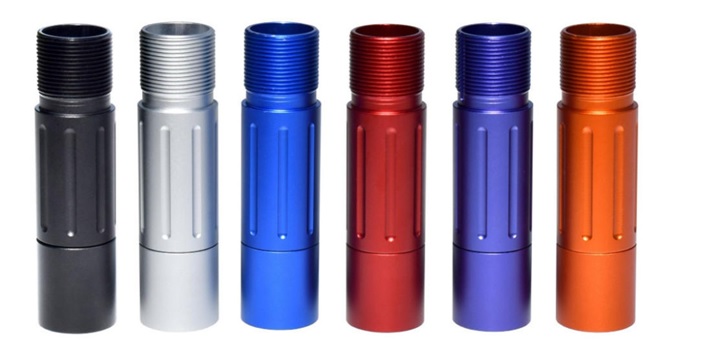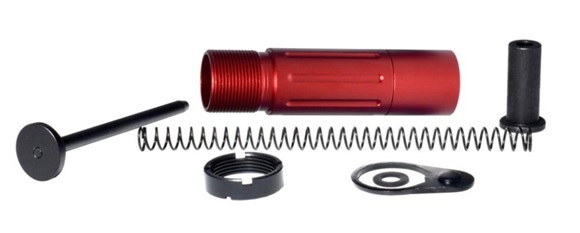The buffer system is an essential component of your rifle’s action that works in tandem with the gas impingement system to cycle the action, returning the bolt carrier group into battery after the action has fired and ejected a round.
But these parts are not standard on rifles, and there are many different types of buffer tube kits and systems, as well as parts, such as springs and buffer weights, which impact performance in their own way.
Here’s what you need to know from a relatively high level.
What Is the Buffer System?
The buffer tube is an aluminum tube that is mounted to an AR-15’s lower receiver. It contains a weight (a series of weights, rather) and a spring.
When you fire the rifle, the gasses expanding behind the bullet propel it forward, until they reach the gas block. They travel through the block, into the gas tube and run backwards until they reach the bolt carrier group’s gas key.
The pressure from the gasses works on pistons in the BCG, rotating and unlocking it, releasing most of the pressure of the gas. The bolt carrier group then moves rearward, extracting and ejecting the spent cartridge.
As it moves to the rear, it contacts the buffer weight inside the tube. The buffer weight comprises some of the reciprocating mass of the rifle, and helps to arrest some of the momentum of the BCG as it moves backwards.
At the same time, the weights compress the buffer spring, which lies behind them. This spring further arrests the momentum of the BCG and converts its kinetic energy into potential energy.
When the BCG moves fully to the rear, compressing the buffer spring, the spring releases its stored energy, rebounding the BCG forward, re-converting this energy back into kinetic energy.
As the BCG moves forward, it strips a new round from the magazine and chambers it. The hammer is cocked and ready to fire, and the bolt carrier group’s lugs lock into place. This repeats the cycle, making the buffer tube system an integral component of the rifle’s functionality.
The buffer tube also serves as the mounting point for the rifle’s stock, if one is present on the platform.

What Comes with a Buffer Tube Kit?
If you buy a buffer tube kit to upgrade your rifle, it usually will come with at least five essential parts. These are:
- The buffer tube itself: The buffer tube is an aluminum component that attaches to the lower receiver, houses the buffer weight and spring, and which itself serves as an attachment point for any stock you intend to mount to the rifle.
- Buffer weight: The buffer weight (or weights, as there is usually more than one) is a weight contained within the tube, which increases the reciprocating mass of the rifle and helps slow the BCG as it moves to the rear.
- Buffer spring: The buffer spring is a spring contained in the buffer tube behind the weight. The spring is responsible for slowing the BCG and rebounding some of its kinetic energy so it can be returned to battery.
- A castle nut: This small piece of hardware is used to affix the buffer tube to the lower receiver.
- A stock receiver end plate: This is another small piece of hardware that is responsible for aligning the lower receiver with the lower receiver extension.
Of course, this is just what most buffer tube systems contain. There are some that might only contain the tube, weight and springs, so read the specifications before buying.
How Does Buffer Weight Affect Rifle Performance?
The buffer weight is one of the most important components of the buffer tube system, as weight will impact cycling speed and reliability. As it pertains to the rifle’s reciprocating mass, the buffer weight also has a direct impact on the force of felt recoil.
There are several standard buffer weight configurations, including:
- Carbine buffer: 3 ounces
- Heavy or standard (H1) buffer: 3.8 ounces
- H2 buffer: 4.6 to 4.7 ounces
- H3 buffer: 5 to 5.4 ounces
- AR pistol buffer weight: 5 to 8.5 ounces
The heavier the buffer weight, the slower the action will be. A heavier buffer weight also works against the bolt carrier group, driving down the force of felt recoil. The thing is, if the buffer weight is too heavy, it can also adversely impact cycling. If the buffer weight is seriously mismatched to the gassing/action, the bolt may not even reset fully, although the culprit may be the spring and not the weight.
On the flipside, a lighter buffer weight allows more recoil to reach your shoulder, but all else being equal, the lighter the weight, the faster and snappier the cycling of the rifle will be.
Adjusting the buffer weight is an easy way to fine tune the performance of your rifle with respect to cycling time, fluidity, and felt recoil, all without the need to adjust the gas system (which is inadvisable unless you know what you’re doing, anyway).
What About Short Buffer Tubes? What’s the Purpose?

With respect to short buffer tubes, such as AR micro buffer tubes, these are generally used in AR pistol builds.
The purpose of the shorter buffer, irrespective of weight or spring type, is to condense the footprint and overall length of the platform even further to improve concealability or compact handling.
Bear in mind, however, that not all AR15 pistol builds require a short buffer tube. Some are built with bufferless AR15 pistol uppers that utilize a blowback action, eliminating the need for a buffer tube system at the root.
Upgrade Your Buffer System Today
Looking for a way to cut felt recoil without messing with the gas system or installing a muzzle device?
You may be able to do that simply just adjusting the weights in the buffer tube - you may not even have to buy a whole buffer tube kit.
Either way, we have the buffer tube accessories, weights and kits you need. Check them out in our collection and get in touch with us if you have questions about parts, performance, or compatibility before buying.

